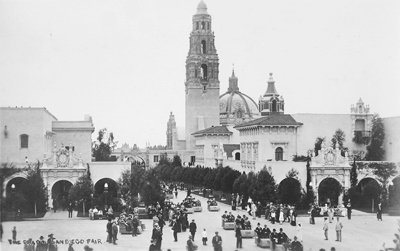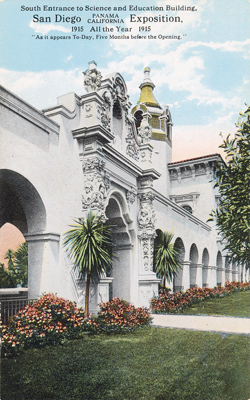|
Resurrection on El Prado
By Mike Kelly
 In March 2002 California voters passed Proposition 40 (The California Clean Water, Clean Air, Safe Neighborhood Parks, and Coastal Protection Act of 2002), approving the sale of 2.6 billion dollars in bonds for "natural resources conservation, state and local park acquisition and improvement, and historical and cultural resources preservation purposes." Six million dollars was awarded to the City of San Diego's Department of Parks and Recreation for Balboa Park projects, including 1.7 million dollars for reconstruction of the West Arcade. In March 2002 California voters passed Proposition 40 (The California Clean Water, Clean Air, Safe Neighborhood Parks, and Coastal Protection Act of 2002), approving the sale of 2.6 billion dollars in bonds for "natural resources conservation, state and local park acquisition and improvement, and historical and cultural resources preservation purposes." Six million dollars was awarded to the City of San Diego's Department of Parks and Recreation for Balboa Park projects, including 1.7 million dollars for reconstruction of the West Arcade.
Built originally for the 1915 Panama-California Exposition, the West Arcade has been absent for the past forty years. Reconstruction is now well under way thanks to Prop 40 state funding, San Diego's Transient Occupancy Tax, Council District Three's Deferred Maintenance Fund, generous donors, and the financial support and perseverance of the Committee of One Hundred, which is "dedicated to the preservation of Spanish Colonial Architecture in Balboa Park."
The missing arcade ran along the entire south and east sides of the Science and Education Building and was demolished about 1965. Most of the buildings along El Prado included arcades, providing Exposition visitors protection from the elements. Today's visitors to Balboa Park will soon enjoy strolling through one more arcade. Sadly, the Spanish Colonial Revival ornamentation on the courtyard entrance, estimated to cost an additional $500,000, has been postponed indefinitely. soon enjoy strolling through one more arcade. Sadly, the Spanish Colonial Revival ornamentation on the courtyard entrance, estimated to cost an additional $500,000, has been postponed indefinitely.
Designed by Carleton Monroe Winslow for the 1915 Panama-California Exposition, the Science and Education Building anchored the northwest corner of Balboa Park's Plaza de Panama. Like most of the buildings built for the Exposition, its wood-frame construction and exterior lath & plaster were meant to last for little more than a year--the planned duration of the Exposition, which was extended to a second year in 1916. In The Architecture and the Gardens of the San Diego Exposition, Winslow said that most of the building was Renaissance in style; that the east frontispiece of the Science and Education Building was inspired by the 16th-century facade of the Church of San Francisco in Puebla, Mexico; and that its octagonal Moorish stair tower, crowned with bright black and yellow tiles, was reminiscent of the colorful glazed ceramics of Puebla.
Campaigns to save the temporary Exposition buildings were mounted in 1922 and again in 1933, when most of the temporary Exposition buildings were condemned as fire and earthquake hazards. The distinctive arcades were crumbling and large pieces of cornices and parapets had broken off. Gertrude Gilbert, who directed the musical programs for the Exposition, likened the plan to demolish the buildings to letting a loved one die because it wasn't convenient to raise money to pay the surgeon. George Marston made his case for preservation of the temporary Exposition buildings when he wrote, "You may prove what you will in facts and figures about the shaky old buildings; the only answer is 'They shall not pass.' Somehow, without knowing how to explain it, we are instinctively, subconsciously, incurably in love with them and will not give them up."
Despite repairs, the temporary buildings continued to deteriorate. A 1957 Citizens Study Committee and a 1960 Master Plan for Balboa Park concurred that both the Science and Education Building and the Home Economy Building (the Exposition building was where the Timken now stands) should be demolished. The Science and Education Building was replaced with a modern structure not in keeping with the architecture of either the Fine Arts Gallery or the surviving Exposition buildings.
Balboa Park has the most complete collection of exposition buildings in the United States, some original and some rebuilt. Visitors to Balboa Park today can imagine what our Panama-California Exposition must have been like 90 years ago.
We will soon have our West Arcade--wouldn't it be grand to rebuild the entire Science and Education Building? David Marshall, now president of Heritage Architecture and Planning and former SOHO president, believes the exterior of the Science and Education Building could be accurately reconstructed from the original 1913 drawings and details and from the many photographs available. Four such temporary Exposition buildings in Balboa Park have now been rebuilt (we know them as the Casa del Prado, Casa de Balboa, the House of Charm and the House of Hospitality.) They serve as a tribute to the preservation of San Diego's defining architecture. Together with the permanent California Building and California Quadrangle, the Botanical Building, and the Spreckels Organ Pavilion, these buildings comprise the architectural centerpiece of Balboa Park and are truly symbolic of San Diego's heritage.
We celebrate the return of the West Arcade. Now let's bring back the entire building!
|
MORE FROM THIS ISSUE
Annual Report
Remember the Alamo
Court Rules
Historical Resources Board - Safe for Now
ASAA Government Affairs Program
Volunteers Make the Difference!
House to be Saved & New Group Formed
Building Ordinance Adopted
Most Endangered List of Historic Resources
Resurrection on El Prado
Courtyards: Intimate Outdoor Rooms by Douglas Keister
Researching James Hubbell
A Beautiful Evening: People in Preservation Awards
SOHO's Annual Meeting: September 24
Glossary of Terms
The Historic Derby-Pendleton House
Meet Victor Santana, Whaley House Head Docent
Volunteerism is at the Heart of the Preservation Movement!!
Found San Diego: Schoolhouse
Craftsman House Available
House by Modernist Architect Gregory Ain Discovered
Don't Miss SOHO's San Diego Modernism Weekend 2005
Strength in Numbers
Lost San Diego
DOWNLOAD full magazine as pdf (4.1mb)
|

 In March 2002 California voters passed Proposition 40 (The California Clean Water, Clean Air, Safe Neighborhood Parks, and Coastal Protection Act of 2002), approving the sale of 2.6 billion dollars in bonds for "natural resources conservation, state and local park acquisition and improvement, and historical and cultural resources preservation purposes." Six million dollars was awarded to the City of San Diego's Department of Parks and Recreation for Balboa Park projects, including 1.7 million dollars for reconstruction of the West Arcade.
In March 2002 California voters passed Proposition 40 (The California Clean Water, Clean Air, Safe Neighborhood Parks, and Coastal Protection Act of 2002), approving the sale of 2.6 billion dollars in bonds for "natural resources conservation, state and local park acquisition and improvement, and historical and cultural resources preservation purposes." Six million dollars was awarded to the City of San Diego's Department of Parks and Recreation for Balboa Park projects, including 1.7 million dollars for reconstruction of the West Arcade.
 soon enjoy strolling through one more arcade. Sadly, the Spanish Colonial Revival ornamentation on the courtyard entrance, estimated to cost an additional $500,000, has been postponed indefinitely.
soon enjoy strolling through one more arcade. Sadly, the Spanish Colonial Revival ornamentation on the courtyard entrance, estimated to cost an additional $500,000, has been postponed indefinitely.


